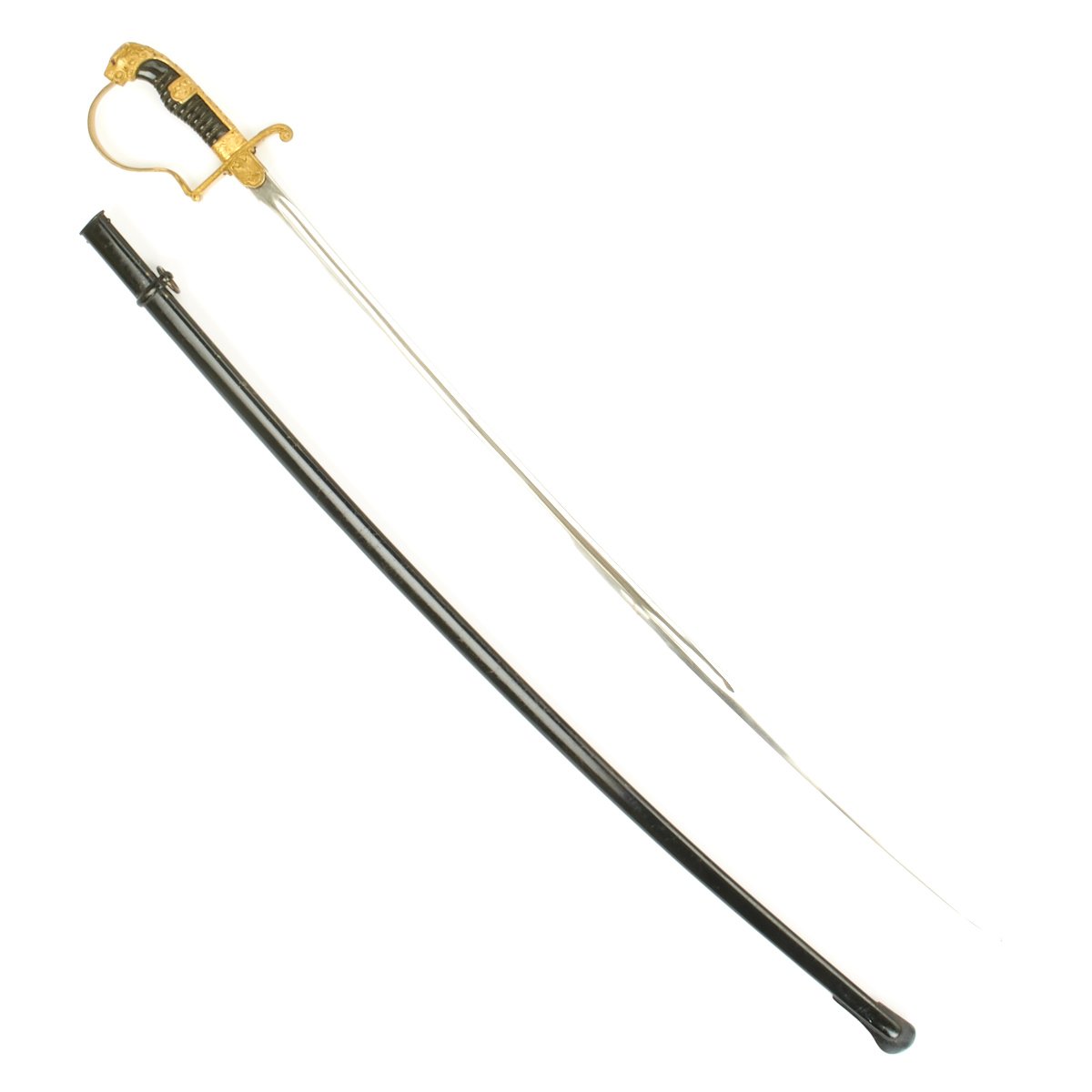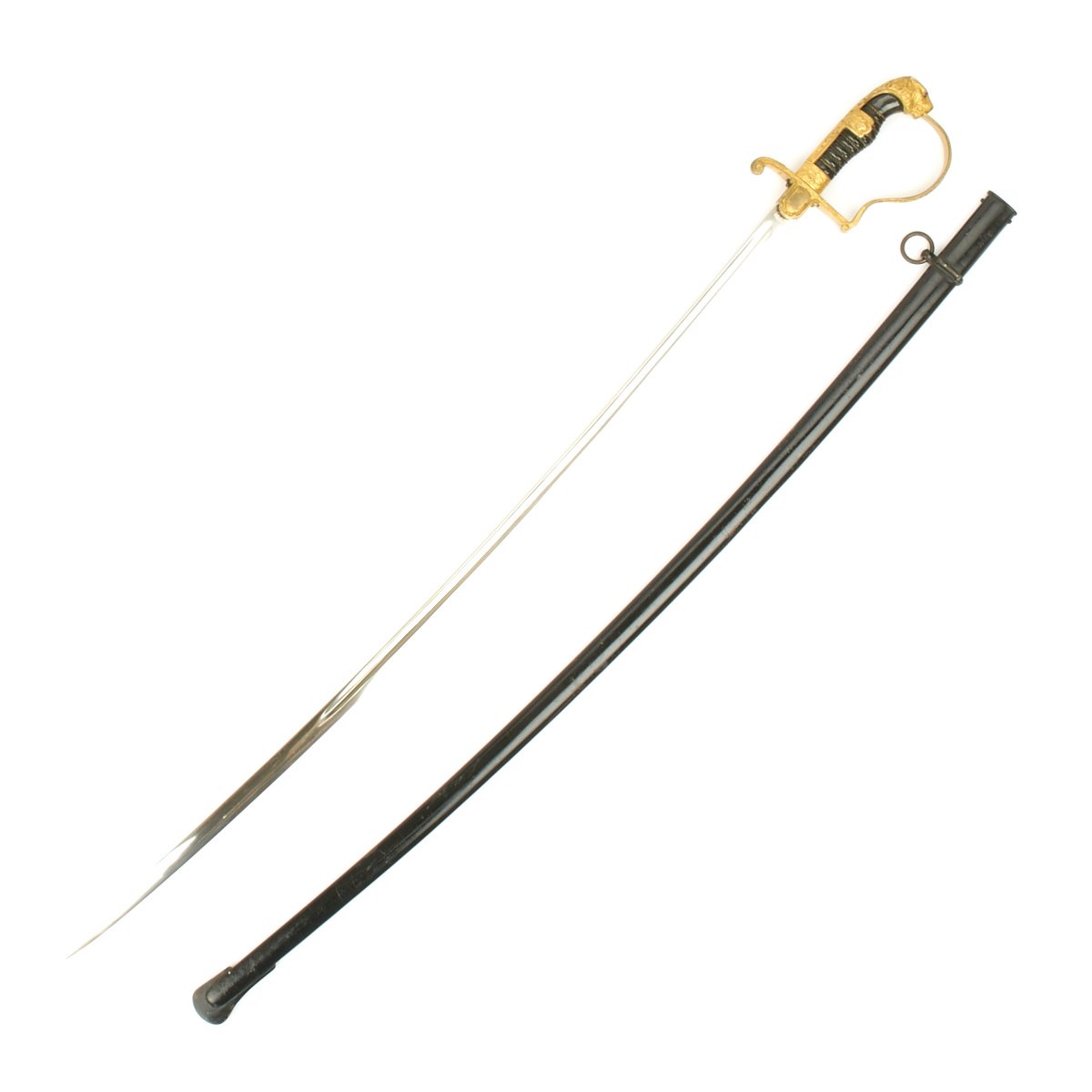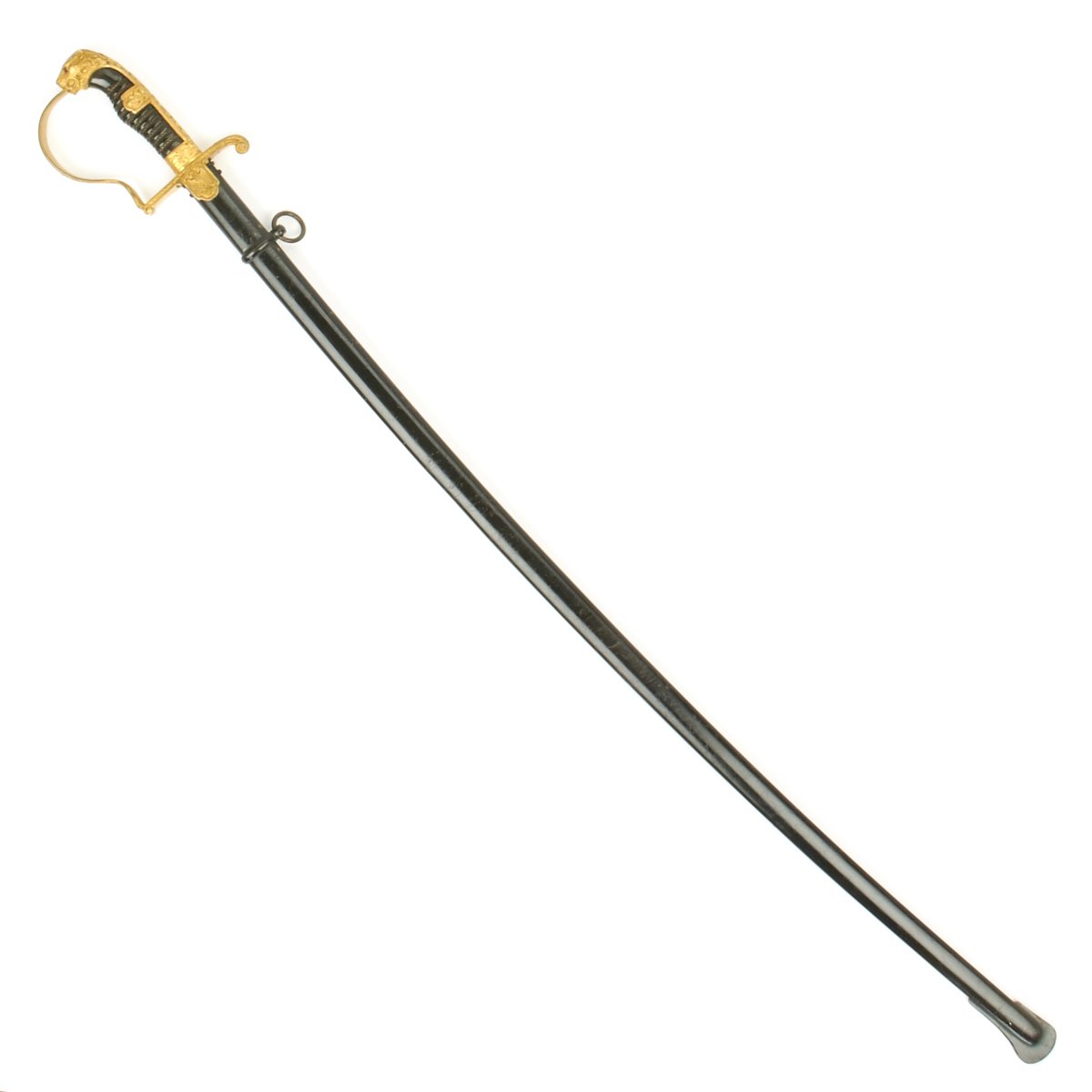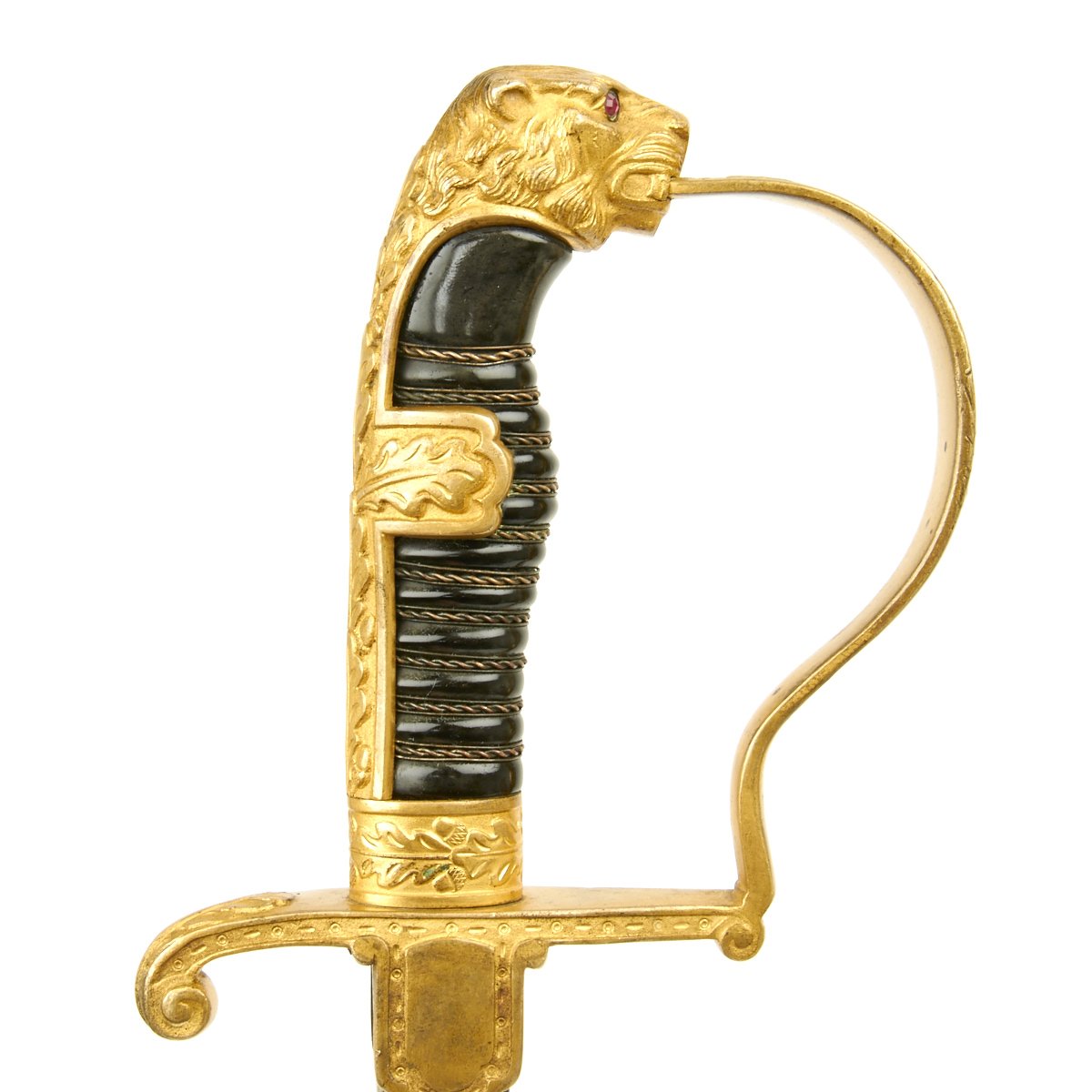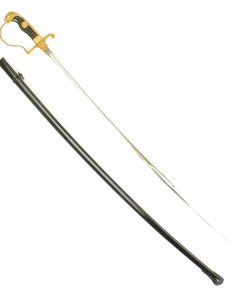Original German WWII Field Marshal Lion Head Scharnhorst Pattern Sword by Eickhorn Original Items
$ 695,00 $ 208,50
Original Item: Only One Available. This is a fine early example of the very desirable “Scharnhorst” variation of the Field Marshal series of German “Lion Head” officer swords. It was made by famed firm Carl Eickhorn of Solingen, the legendary “City of Blades” in western Germany. The Field Marshal series was quite popular, and had many different variations. This piece is also a real treasure as it is not constructed from the usual aluminum, but rather is made of solid brass. It really looks magnificent, retaining much of the finely gilded finish.
The blade on this sword is an excellent example. It measures 32 inches and has the highest quality nickel plating. This plating is still bright with only small spots of wear and oxidation. The reverse ricasso is stamped with the 1935-41 ORIGINAL EICKHORN SOLINGEN stamped squirrel logo. The original leather washer is still in place, though it is somewhat cracked from age.
The Pattern 1706 – Scharnhorst sword is named after General Gerhard Johann David Waitz von Scharnhorst (12 November 1755 – 28 June 1813) who was a Prussian General and Chief Staff noted for his reforms of the army and for leadership during the Napoleonic Wars. This pattern features a great looking leopard or lion head with brows that jut out well over the faceted red eyes. The detailing to the head of this cat is outstanding, with handwork evident on the lower jaw, whiskers, muzzle, brow and even to the mane which flows partially down the backstrap. It features a less ornate grip than some of the other patterns, with simple leaf and acorn designs on the back strap, “P”-guard and ferrule. However, the detail on the leaves is exquisite. The cross guard has a Wehrmacht open-winged eagle which looks to the viewer’s left. This art-deco eagle has fine crispness to his eye, breast feathering and raised out swas within a wreath.
The grip is of carved wood covered in black celluloid. This celluloid is in good condition and remains very shiny, only having a few small cracks. The grip is tightly wrapped with a skein of copper wires, the center two being twisted together. The top of the cross guard is hilt is stamped GES. GESCH., indicating it was a trademarked design.
The scabbard of this example is in very good condition, having the original black paint present. This black paint is 95% throughout and still has a bright finish towards the top. Most of the body has some degree of finish checking and lifting, and the expected wear of age.
This is a wonderful looking sword, from a very prestigious maker. If you are looking for an excellent example to hang on the wall, this one should do it!
The German Army (German: Heer, was the land forces component of the Wehrmacht, the German armed forces, from 1935 to 1945. The Wehrmacht also included the Kriegsmarine (Navy) and the Luftwaffe (Air Force). During World War II, a total of about 15 million soldiers served in the German Army, of whom about seven million became casualties. Separate from the army, the Waffen-SS (Armed SS) was a multi-ethnic and multi-national military force of the Third Reich. Growing from three regiments to over 38 divisions during World War II, it served alongside the army but was never formally part of it.
Only 17 months after AH announced publicly the rearmament program, the Army reached its projected goal of 36 divisions. During the autumn of 1937, two more corps were formed. In 1938, four additional corps were formed with the inclusion of the five divisions of the Austrian Army after the Anschluss in March. During the period of its expansion by Adolf AH, the German Army continued to develop concepts pioneered during World War I, combining ground (Heer) and air (Luftwaffe) assets into combined arms teams. Coupled with operational and tactical methods such as encirclements and the “battle of annihilation”, the German military managed quick victories in the two initial years of World War II, prompting the use of the word Blitzkrieg (literally lightning war, meaning lightning-fast war) for the techniques used.
The German Army entered the war with a majority of its infantry formations relying on the horse for transportation. The infantry remained foot soldiers throughout the war; artillery also remained primarily horse-drawn. The motorized formations received much attention in the world press in the opening years of the war, and were cited as the main reason for the success of the German invasions of Poland (September 1939), Norway and Denmark (April 1940), Belgium, France and Netherlands (May 1940), Yugoslavia (April 1941) and the early campaigns in the Soviet Union (June 1941). However their motorized and tank formations accounted for only 20% of the Heer’s capacity at their peak strength.
Fast Shipping with Professional Packaging
Thanks to our longstanding association with UPS FedEx DHL, and other major international carriers, we are able to provide a range of shipping options. Our warehouse staff is expertly trained and will wrap your products according to our exact and precise specifications. Prior to shipping, your goods will be thoroughly examined and securely secured. We ship to thousands clients each day across multiple countries. This shows how we're dedicated to be the largest retailer on the internet. Warehouses and distribution centres can be located throughout Europe as well as the USA.
Note: Orders with more than one item will be assigned a processing date depending on the item.
Before shipping before shipping, we'll conduct a thorough inspection of the items you have ordered. Today, the majority of orders will be delivered within 48 hours. The delivery time will be between 3-7 days.
Returns
The stock is dynamic and we cannot completely manage it because multiple stakeholders are involved, including our factory and warehouse. So the actual stock may alter at any time. It's possible that you may not receive your order once the order has been made.
Our policy is valid for a period of 30 days. If you don't receive the product within 30 days, we are not able to issue a refund or an exchange.
You can only return an item if it is unused and in the same state as the day you received it. You must have the item in its original packaging.
Related products
Uncategorized
Uncategorized
Uncategorized
Armoured Fighting Vehicles of the World: AFVs of World War One (Hardcover Book) New Made Items
Uncategorized
Australian WWII Owen MK1 Machine Carbine SMG Custom Fabricated Replica with Sling Original Items
Uncategorized
Uncategorized
Uncategorized
Uncategorized
Uncategorized
Band of Brothers ORIGINAL GERMAN WWII Le. F.H. 18 10.5cm ARTILLERY PIECE Original Items
Uncategorized
Uncategorized
Uncategorized
Uncategorized
Uncategorized
Uncategorized
Uncategorized
Uncategorized
Angolan Rebel 1970s era 60mm Inert Display Mortar from Angolan Civil War Original Items
